Municipal treasury educational institution
Novosibirsk region, Novosibirsk region -
Plotnikovskaya secondary school No. 111
Address: Russia, Novosibirsk region, Novosibirsk region, village Plotnikovo
st.Beregovaya, 19
Natural sciences (geography)
The impact of climate on traditional homes of people in different parts of the world
Head: Lavrentieva Svetlana Vladimirovna,
geography teacher
Content
Introduction 3
Chapter 1. The theoretical part
1.1. The main climatic factors .. 5
1.2. Climatic zones. 5
1.3. Design features of climate-dependent dwellings. 7
Chapter 2. The practical part
2.1. Traditional dwellings of peoples living in the equatorial climate
belt 8
2.2. Traditional dwellings of peoples living in a subequatorial climate
belt .. .. 9
2.3. Traditional dwellings of peoples living in a tropical climate
Belt. 10
2.4. Traditional dwellings of peoples living in a subtropical climate
belt 11
2.5. Traditional dwellings of peoples living in temperate climates
belt .. ... 11
2.6. Traditional dwellings of peoples living in the subarctic and arctic climatic zones 13
Conclusion 15
Sources of information 16
Once upon a time people lived
No roofs overhead
The rocks were protected
And forests are shelter alive.
Flickers year after year
Goes century after century,
Depend on nature
The person does not want.
Useful tools
By creating with your labor,
People have become stronger
And now - the house is built!
Anatoly Roshchin
Introduction
All over the world, people build houses to have shelter and weather protection. For many peoples living in different parts of our planet, the concept of "bad weather" has a different meaning. Somewhere bad weather is heat and incessant rain, and somewhere frost and blizzard. People live everywhere: beyond the Arctic Circle, in mid-latitudes, high in the mountains, in the steppes and deserts. Natural conditions are different everywhere, but people adapt to live in different climatic conditions. And to live, you need to build a home.
As you know, the national houses of the peoples of the world are very diverse in form, layout and materials used for construction. And if the form and layout of dwellings most often depends on national traditions, then the choice of building material is dictated by natural and climatic conditions, as well as the way of life of the people (settled or nomadic). In the construction of dwellings, people use wood, stone, clay, grass and shrubs, tree leaves, fabrics, animal skins and even snow, silt and dung.
Recently, interest in climate accounting issues in the construction of residential buildings has greatly increased. People need more housing. There was a problem of mass housing construction in areas of new industrial and agricultural development. Therefore, interest in construction in deserts, in the North and in mountainous regions, interest in protecting homes from showers, dust, etc. is logical. The task of new construction determines the need to expand our knowledge in the field of architectural and construction climatology, to identify patterns of climate accounting in architecture. But in order to create something new, it is necessary to study the previously accumulated experience of nationalities in the construction of traditional houses.
The problematic question of our study: what explains the variety of types of traditional dwellings of people living in different corners of the Earth?
Purpose: to prove the relationship between climate and the type of traditional dwellings of people in different corners of the Earth and to create a visual geography guide that demonstrates this dependence.
To achieve this goal, the following tasks were solved:
1. To study the material of the geography textbook on climate and its types.
2. To select and analyze information from various sources about the traditional dwellings of people in different parts of the world.
3. Determine whether the type of housing depends on the climate.
4. Select materials for the manufacture of models of houses.
5. Construct house models from improvised materials and place them on a world map.
6. To analyze the results of work and draw conclusions.
The novelty and practical significance of this research project lies in the fact that we have created a manual for geography lessons, which can be used in elementary and basic schools to increase interest in studying the subject.
The object of our study is the traditional dwellings of people. The subject of the study is the connection between climate and structural features of dwellings.
At the beginning of the study, we suggested that there is a close relationship between the type of climate and the type of traditional dwellings of people: the harsher the climate, the warmer and more durable a person’s house should be.
In the research process, the following methods were used:
Theoretical:
Selection and analysis of information from scientific sources about the types of climate and traditional houses of people.
Comparison of housing types.
Analysis of the data.
Experimental:
Modeling of housing models from various materials.
Photographing project results.
Chapter 1. The theoretical part.
Key climatic factors
From the weather forecasts that are broadcast on television and radio, published in newspapers and the Internet, it can be seen that the weather is different in different parts of the Earth.
Changes in air temperature, atmospheric pressure, wind, precipitation and moisture in the air, clouds occur in the lower part of the atmosphere. All these phenomena characterize the weather. Weather is the state of the lower atmosphere (troposphere) in a given place for a certain period of time.
Weather in one and the same place on Earth is constantly changing, but each area is characterized by a special weather regime called climate.
The climate in each area of \u200b\u200bthe globe has its own characteristics. In the equatorial part of the Earth every day is hot weather with heavy rain. In the circumpolar regions of the Earth, the weather is cold all year round, so the snow on land there almost does not melt and turns into a glacier over time. In our (middle) latitudes, the seasons change: the warmest season is always summer, and the coldest is winter.
The main characteristics of the climate are average temperatures, average annual rainfall and mode of precipitation, as well as information about the prevailing winds.
Climatic zones
Due to the uneven distribution of solar heat and precipitation on the Earth’s surface, Earth’s climates are very diverse. The famous climatologist Boris Pavlovich Alisov identified 13 climatic zones on Earth that differ from each other in temperature conditions and air masses (Fig. 1). Climatic zones are divided into basic and transitional. Transitional climatic zones are located between the main zones, their names contain the prefix “sub”, which means “under” in Latin.
Climatic zones:
equatorial climate zone - from year to year there is uniformly hot and humid weather;
subequatorial belts - the climate changes in two seasons: in summer it is similar to equatorial, and in winter to tropical;
tropical zones - there is very high temperature and little rainfall all year round;
subtropical zones - the climate changes in two seasons: hot summers and warm winters;
temperate zones - seasons are clearly pronounced here (winter, spring, summer and autumn), much colder than in the tropics and significant annual rainfall;
subarctic and subantarctic zones - two seasons are distinguished: moderate prevails in summer and arctic air in winter;
the Arctic and Antarctic zones - here, with a small amount of precipitation, low temperatures and strong winds all year round.
Climate-specific housing features
When building a house, first of all, the peculiarities of the climate of the area in which the house is being built are taken into account and in accordance with this, the shape of the house and its layout, building materials, acceptable designs and the necessary thermal protection are selected. At the same time, such requirements for the house as warm, dry and comfortable remain decisive in most cases. What physical and climatic factors, temperature and humidity, wind speed and direction, snow depth and amount of precipitation, the depth of freezing, the number of sunny and cloudy days in a year should be taken into account when building a cozy house?
Compact houses with thick heat-insulating walls and small windows have long been built in cold regions, in warm and humid pavilion-type for the possibility of through ventilation, in dry desert areas with massive walls that allowed to stabilize huge daily temperature fluctuations, and sometimes even buried or underground.
Depends on the outdoor temperature.
The most important factor influencing the choice of building material for the walls of the house is the outdoor temperature. In a log cabin or in a house with massive walls on a frosty day, a person does not feel the cold. Such houses are built in harsh climates, where temperatures are low in winter.
If the outside temperatures are high year round, then the walls can be made of thin, lightweight materials. Or, conversely, make dwellings in the recesses of the rocks so that the thick walls keep cool inside the dwelling.
Dependence on humidity.
In addition to the outside temperature, the humidity in the construction area must also be taken into account. Moisture has a huge impact, very often negative, on the thermal performance of fences. It is known that water conducts heat very well, and air, especially dry, has heat-insulating qualities. Therefore, building materials with a large number of pores filled with air have good heat-shielding properties. However, if the pores are filled with moist air or moisture penetrates into them, the thermal insulation ability of any material is impaired. In addition, moisture dissolves chemicals, which leads to the rapid destruction of materials. The walls are damp, the microclimate of the premises is sharply deteriorating, a person will chill and often catch a cold.
Dependence on the wind.
Considering the influence of climatic factors on the thermal protection of a house, one cannot but mention the wind, which brings a lot of trouble in the cold season. Indeed, at an air temperature of about -5 ° C and a strong wind, a person freezes in the same way as in a 25-degree frost. The wind helps the penetration of cold air into the room, more intensive movement of air inside the house. Strong drafts weathering heat from the rooms lead to lower internal temperatures and a sharp increase in heat loss in winter.
Part 2. Practical.
Traditional dwellings of peoples living in the equatorial climate zone.
Equatorial Africa, Indonesia, Amazonia (South America). The sultry and humid equatorial climate in the dwellings requires protection from the sun, rain and poisonous insects.
You can say about these places: “Here, if it is raining, it is so raining, if a tree is so giant, if a butterfly is like that with a bird, and if a house is like that on stilts.” When the time comes for the Great rains, it pours for a month like a bucket. Wherever you step, water is everywhere. And in the houses it’s dry, because the “stilts” raise them high above the ground. Do not get water. Yes, and snakes, insects and rodents are difficult to climb.
Houses here are built in the form of huts, tents and awnings, they are necessarily raised above the ground.
The building material is branches of low shrubs, bamboo, palm trees, clay. Depending on the climatic zone, the dwellings are covered with leaves of ficus, banana and other herbs. The connecting material is always clay, sand and camel manure.
I made models from dry grass, branches, sticks.
Traditional dwellings of peoples living in the subequatorial climate zone.
New Guinea. The cow tribe live in tree houses, some of which reach 40 meters in height, so they avoid the attack of large predators, a variety of small pests. The house is light, made of straw and branches, because protection from the cold is not required, as it is hot all year round.
Traditional dwellings of peoples living in the tropical climate zone.
Mexico, Sahara desert and southern Africa, Arabian Peninsula, Australia. People’s dwellings here must be protected from the scorching sun, sand storms.
Mexico. Anasazi is a prehistoric Native American culture that existed in the modern United States. Anasazi is characterized by its own style of construction of dwellings: houses were built from clay or cut down directly in the rock. Thick walls protected from heat. Multi-story dwellings with thick stone walls and small windows are typical of a dry, hot climate.
Sahara Desert. The traditional dwelling for the Bedouins was felts made of felted camel or goat hair, painted black. Felidge - this is the name of this tent. Such a dwelling successfully resists the effects of drying winds and sand. Even such winds as a burning sumum or sirocco are not terrible for the nomads who have taken refuge in tents.
Traditional dwellings of peoples living in the subtropical climate zone.
Central America, the Mediterranean, Central Asia, Japan; South Africa, South America and Australia.
Minka (minka; literally "house of people") is a traditional Japanese house. The "skeleton" of the house and roof, walls and supports are made of wood.
In the manufacture of external walls, bamboo and clay were often used, and internal walls were not erected, and instead of them sliding walls were used.
High roofs made it possible to dispense with a chimney and arrange extensive storage rooms, as well as, first of all, protect the house from moisture, because the climate on the Japanese islands is humid.
Thanks to the roof construction, snow or rain immediately rolled down without stopping, so the roof was "waterproof", and the straw covering it almost did not rot.
Traditional dwellings of peoples living in the temperate climatic zone.
North US, South Canada, Europe, Asia. South South America.
From time immemorial, people in Russia have lived in chopped wooden houses - huts. Carpenters chopped a hut of spruce or pine logs and covered it with a roof made of plank boards. A log house with wooden walls has the properties of a natural air conditioner that provides air renewal twice a day. The thermal conductivity of wood is such that in the winter the house keeps warm, and in the summer, coolness is maintained. The corners of the house are tightly and securely connected in the castle and do not freeze.
In Germany, the traditional dwelling was a one-story or two-story frame house. The frame of wooden poles is connected on top of the crossbars, plastered and whitewashed. Such a building accommodates living rooms, a barn and a barn under one roof. Inside, it is made in the form of a large hall with rooms located on each side. Since the country is located in the temperate sea belt, with a transition to the continental climate, it is extremely rare to have a variety of natural disasters (severe frosts, heat, storms, etc.) and the frame house fully fulfills its protection functions.
Because of the nomadic way of life, North American Indians required their home to be easily moved from place to place. Therefore, they came up with a special design of poles with skins thrown on them. Such a building is called tipi, it is sometimes mistakenly called a wigwam. "Ti-pi" ("for life" in the language of the Lakota Indians). Tipi covered with birch bark, later hides, are typical of the temperate continental climate of the Great Plains.
The ancient Mongols, Kazakhs, Kirghiz, Yakuts and many other peoples who built their homes on the same principle were their yurts, which even now have not forgotten how to do this. A yurt is a dwelling made of felt (a specially made coat of domestic animals, for example, sheep). The yurt protects from the steppe climate of strong winds and temperature extremes. Felt coverings cool in the summer and keep the hearth warm in the winter.
The word "yurt" means, in translation from Turkic, "home, homeland."
Traditional dwellings of peoples living in the subarctic and arctic climatic zones.
The north of Canada, Yakutia, Karelia, Magadan, Kamchatka and Murmansk regions as well as the islands of the Arctic Ocean and its seas.
Due to the harsh climate, this region is one of the most difficult for people to live. About 40 northern indigenous peoples live here - Eskimos, Nenets, Pomors, Enets, Chukchi, Evenks, Yukagirs, etc. For many centuries, they have maintained the traditional way of life established by their ancestors.
The Chukchi live in the distant Chukotka, which they call Chau-chu, which means "rich in deer." Yaranga is the home of the Chukchi. Instead of walls, this house has poles covered with deer skins. Inside, a square room is fenced off with deer skins. Here people sleep, eat. And behind the canopy they have pantries and a kitchen. Fire bursts in an iron stove, warming the yaranga.
Neither caves nor wood are accessible to the inhabitants of the northern regions. They cut bricks for their homes from the most accessible material - snow. Such houses, which are called igloos, are being built by northern peoples now.
The igloo is being built by Canadian Eskimos living beyond the Arctic Circle. It is made of large blocks of snow. Furniture in the house is also made of snow. The building is given a domed character, due to which it retains heat in the room. The gradual icing of the surface makes the building very durable. An interesting fact is that when the air is heated, the inner surfaces of the walls of the needle melt, but do not melt due to the fact that the snow quickly removes excess heat outside the house, and due to this, a temperature that is comfortable for a person is maintained in the room. Moreover, snow walls are able to absorb excess moisture, so the needle is always dry.
All the housing models we have located on the climatic map of the world:
Conclusion
As a result of the study, we concluded that the type of traditional human dwellings depends on the climate, available natural materials, human skills and tools.
A person’s dependence on weather and climate is direct, tough, and in many respects decisive for his health, economic activity, and life! Thus, the hypothesis that there is a close relationship between the type of climate and the type of traditional dwellings of people has been confirmed.
So, if the climate is warm, without sharp changes in temperature, then the dwellings are quite simple, the walls are thin. The main thing in such conditions is to build walls and a roof that would protect from rain and heat. To build such houses, it is enough to be able to weave tree branches or dig holes.
If the climate is harsh, cold and windy, then people have to build warmer and more durable homes.
During the research work, models of dwellings were created: a stilt house, a hut, a canopy, a tree house, a house in a rock, a felage, a hut, a German house, a tipi, a yurt and an igloo. It is planned to create more mock minks, yaranga and wigwam.
The material found during the study, and the created models of the dwellings will be a guide for geography lessons in a primary school and the “World around” lessons in elementary school.
Knowing the basic climatic factors and the features of their influence on the quality of building materials allows people to build houses on their own, as well as make it warm, dry and comfortable.
Information sources
Gerasimova T.P. Geography. Beginner course. 6 cl .: a textbook for educational institutions / T.P. Gerasimova, N.P. Neklyukova. - M.: Bustard, 2013 .-- 159 p.
Korinskaya V.A. Geography: The geography of continents and oceans. 7 cl .: textbook / V.A. Korinskaya, I.V. Dushina, V.A. Shchenev. - M.: Bustard, 2014 .-- 335 s.
Dietrich A., G. Jurmin, R. Koshurnikova. How much. Encyclopedia for children.- M.: Pedagogy, 1987.
13PAGE \\ * MERGEFORMAT141615
Antarctic
Tree House Model
The tipia model is made of white non-woven and wooden sticks
The igloo model is made of foam and paper.
The model of the yurt is made of a plastic frame and fabric.
The model of the felage - the Berber tent is made of black non-woven fabric and straws for a cocktail.
Winter and summer in the tundra and forest-tundra
Model hut made of branches and planks
The model of the German house is made of polystyrene, paper and wooden sticks.
Stilt House Model
Hut model
Canopy model
Model house in the rock
The model is made of dry leaves, sticks and matches.
The model is made of polyurethane foam, painted with gouache.
Section 1. "MY HOUSE"
Theme. "WHERE AND HOW WE LIVE." Lesson 4.
Purpose: To acquaint children with the concepts of "Far countries", "Globe", "Climate", with the living conditions of people in distant countries.
Tasks: 1. Introduce children to the globe, map. 2. To form the concept of different conditions of human life in different parts of the planet. 3. Show the human dependence on climatic conditions. 4. Observe how a person adapts to the conditions that surround him.
Lesson equipment : globe, map, textbook, pictures of human dwellings in different climatic zones.
Class progress
Checking homework
Stories on the topic "What health depends on" and "My home is an ecological system."
What provides a comfortable life for a person in the house? (Light, heat, water, food).
The man is the master in his house, he is responsible for the order in it. And what is the order in the house?
These are all living conditions that a person forms and regulates. Man himself must take care of himself and others.
Work on the topic of the lesson: "Where and how do we live?"
Answering the teacher’s questions, children find out that there are territories with different climates on our planet. The most characteristic of them are distinguished: far North, taiga, steppes and deserts, mountainous regions, tropics.
1. North. The home is called PLUM. How is it built? Why is it convenient? The dwelling of the northern peoples is adapted for nomadic life. The inhabitants of the North are mainly engaged in fishing and reindeer husbandry. Reindeer need new pastures and people often have to change their place of residence, to roam. The house is built quickly from poles (thin trees), they are covered in deer skins (see picture). Northern peoples eat meat and fish. The plague is warm, a fire burns there and an ear is prepared from delicious fish. If the northern peoples change their way of life, their housing changes. In the far north there is no scaffold. In the cities built in the far North, almost everything is made of their materials imported from other parts of the country.
Kovalenko N.D.
I live in the northern part of the planet
And I admit, I do not regret it at all.
Snow and deer, and my native plague,
A river with cold and clear water,
Frosts and blizzards surround me
I can’t do without them; they know this.
I do not need a hot and sunny south.
Love when the plague, deer around.
2. Taiga.Housing - log cabin. People are engaged in hunting, harvesting mushrooms, berries, harvesting wood. Houses are built solidly and permanently. Scaffolding - PINE. The wooden house is warm, easy to breathe.
3. Steppes and deserts. Steppes occupy large spaces. People also live there, they are engaged in cattle breeding. There the dwelling is called YURTA. This is a temporary home. A nomadic way of life is necessary in order to feed livestock on new pastures. A yurt is like a plague, but it is larger in size and different in shape.
4. Highlands. Mountains are inhabited by many nationalities. They adapted to live both at the foot of the mountains and high in the mountains. People also build housing and there is a lot of material there. This is a stone. Houses made of stone are very durable, they can stand for centuries. In winter, the house is warm, and in summer it is cool. The windows in these houses are small.
I'm a highlander and proud of it
That I wake up with the dawn
And I see: the clouds below are floating,
Good people live here.
Thank you to mother Earth,
What life gives you and me
5. The tropics.Eternal summer in the rainforest. But there is also a heavy rainy season, so people build houses on special logs, raise them higher from the ground so that rainwater does not flood the dwelling. In this part of the planet, houses are built from tropical plants. Thick pine logs are not needed there, as in Siberia, where it is cold. Here, warmth and housing are more needed for salvation from the heat, the scorching sun. It is also convenient to live in such a house, although it is built of tropical trees, huge leaves.
So a person adapted to the area where he lives.
Question: Can residents of different parts of the world and natural areas change their homes? Why can't they?
Kovalenko N.D.
My Home is Native! The planet is blue!
Live, dear, grief, misfortune without knowing.
Earthlings - we are your own children,
You are the best for us in this world.
You gave birth to us, Mother Earth-Planet!
We are grateful to mother for this!
Cosmic distances beckon to themselves,
Long-distance flights, awards and medals.
Yes, no matter how long they fly,
Homeland - Mom was remembered.
And we still flew to her,
They thought: they were alive if they stood on the ground.
Cosmic distance, don’t wave,
O people, you take a look at the planet.
She is cute and so beautiful
And in people she has all the power!
O man, you are an earthly creature,
Turn on your "fifth" consciousness.
Keep your house - a blue planet.
The only thing you can’t find.
You think far ahead
Then the planet will not die.
Years will pass, you will become a grandfather,
You will only be happy at the same time.
Let life go and not stand still
Everyone on the planet is not crowded.
And the only thing is that life should be
Planet - Mother lived!
Total.
Homework.
The human home, like man himself, has a history. In the most distant antiquity, people did not erect buildings, but adapted to the conditions of the nature that surrounded them. In mountainous places they were hiding from the weather and a fierce beast in caves, probably it wasn’t so bad: it’s dry, warm, you can also warm yourself by the fire and get enough sleep on a fur coat.
In the hottest climate, one could hide behind an ordinary wind screen, and it was easy to make it from branches or tree bark. Ancient people living in warm and humid climates preferred living in grass and straw houses. Therefore, in the countries of Africa and on some islands of the Pacific Ocean, houses were built from grass, from bamboo, from leaves of climbing plants that grew right there. When a stone ax was invented thousands of years ago, the ancient bang began to make houses of wood. Archaeologists have unearthed a lot of the remains of a wide variety of dwellings, which are at least 300,000 years old. 35000-10000 years ago in the Ice Age, where there were no trees, hunters make shelters for the winter from huge bones and skins of mammoths. The ruins of such dwellings belonging to several families were found during excavations near Voronezh and in Ukraine (Upper Paleolithic).
This dwelling looked something like this: along the circumference of a circle with a diameter of 3-4 meters there were mammoth skulls, bonded bones were inserted into these skulls, forming a domed overlap. The entire structure from above was covered with skins that were crushed by stones. For the construction of such a dwelling more than 10 mammoths were required. Where could people get so many mammoth bones? After all, the mammoth was one of the most dangerous animals, and the hunt for it could end tragically not only for the mammoth, but also for humans. Fortunately, humans do not have to kill a mammoth to get its bones. Mammoths, like some other animals, “prefer” to die in any one particular place. So over time, their whole cemeteries are formed. It is known that such cemeteries are in Siberia in the permafrost zone.
About 30,000 years ago, Wandering hunters move from Siberia to America on the ice of the frozen Bering Sea and become the first Americans. They build simple shelters from everything that comes to hand: from wood, earth, branches, animal skins. About 12000g. back in Europe, nomadic hunter communities build winter camps for large families using trees surrounding dense forests.
Later, when people learned to cultivate the land and grow crops, they began to build solid permanent houses. Their settlements moved from hunting and gathering places to fertile plains: the field required constant cultivation. On such plains, archaeologists dig up huge hills that have grown out of the blue. These are the remains of ancient settlements, replacing each other for many centuries. Such settlements were found in Western Asia (the so-called vast region of Asia, stretching east of the Mediterranean Sea), in the valleys of large rivers, at the foot of the mountains - where there is fertile land. There are no forests in this area, so people built houses of clay. The roof was made of straw. Such houses quickly became dilapidated and new houses were erected over clay ruins. Therefore, on the site of ancient settlements, high hills grew, which so surprise archaeologists.
When excavating clay hills, scientists found that the settlements of farmers were large and densely populated. The houses were molded to each other, between them narrow streets. They did not make windows in houses - in southern countries they value shade and coolness in a dwelling, where you can hide from the heat. The hearth was made of clay bricks in the house; mats woven from straw were laid on the floor. What kind of dwellings were not created by different peoples: round, square, high, low, with and without walls, standing on the ground and on support pillars, like huts on chicken legs. In New Guinea, houses have been built and are still being built on trees that look like large bird nests. How did you do it? Choose a tree larger and taller. At 5-6 meters from the ground to its forked branches, which serve as a ready support, a rectangular frame is tied. Then they build ceilings and a gable peaked roof, arrange a comfortable kitchen and the "air house" is ready. Now you can move into it, or rather climb. The shape of the houses was not specially invented by architects, as is happening now. She rested on the oldest traditions that the master builders passed on to each other. That is why the houses of the steppe peoples do not resemble the houses of the inhabitants of the taiga and on the islands in the ocean they build completely different houses than in the taiga or in the tundra.
Traditional housing was associated with the lifestyle of the people and took into account the natural conditions and needs of people, as well as the features of their culture. The peoples living in the forest strip made log houses made of wood. This is a wonderful reliable building material, which in former times was not expensive and did not require much labor for processing. Living in a wooden house was convenient and useful. In an area where there was no forest or there was too little, houses were built of clay and brick. In countries with a hot climate, reed, straw, and tree bark were used. Mats were made of straw and reed, and such a wall was quite enough.
Requirements for the nature of the home depend primarily on the climate of the territory. There is a “climatic-structural zoning” of the territory of Russia, where housing requirements are formed for each of the regions: what should be the thickness of the walls, the nature of the glazing, heating, and so on. To ensure a comfortable microclimate in different areas in a home, a different degree of isolation from the external environment is needed. For example, in the Far North, windows should have triple glazing, powerful heating and mechanical supply ventilation (inflow of heated air) and natural exhaust should work. And in the summer on the Black Sea coast of the Caucasus, housing should protect only from rain, and in winter you can live with open windows.
Climatic conditions affect both the need for living space and the layout of apartments. The more time a person spends in his apartment, the more spacious it should be. So in the Far North, the norm of living space, according to architects, should approach 15-18 square meters per person, and the number of rooms should exceed one number of family members. In areas of hot climate, summer rooms are needed: verandas, unglazed terraces and so on; here houses should have a through ventilation.
In addition to climatic conditions, a number of other environmental conditions affect the housing requirements: the nature of the soil (including the presence or absence of permafrost), seismicity require more stable house designs), rainfall (for example, flat roofs in a public dwelling are found only in arid areas) and others.
Climatic conditions to a large extent determine the nutritional needs of the population. For example, the required caloric intake for men 18-40 years old when working, not related to the cost of physical labor or requiring little physical effort, is 3450 calories per day in the North, in the central regions of Russia - 3000, and in the southern regions - 2850. Different should there is also the composition of the products: in the North there is a larger proportion of proteins and fats of animal origin, since under these conditions the digestibility of all nutrients, especially protein, decreases. If in the central regions of Russia the amount of fat in the diet should be 25% of the total daily calories, then in the eastern regions this indicator increases to 35%.
Opportunities for recreation in a particular area are also largely determined by natural conditions. For example, the number of days in a year favorable for swimming varies from 120 or more on the coast of the Black and Caspian Seas to 30 or less in the Arkhangelsk Region, and, alas, there are no such days at all in Chukotka. The presence of such recreational resources as healing mud, healing mineral water is also important.
A special recreational resource is the picturesque landscape, its aesthetic qualities. Recently developed methods for assessing these properties, taking into account primarily the diversity of landscapes. For example, a solid forest or a solid steppe is less attractive than the alternation of forest and steppe; homogeneous plains are less interesting than hilly and others. Even maps of the “aesthetic resources of the landscape” were compiled, highlighting the most aesthetically valuable territories.
Assessment of the natural conditions of human life
So, we examined the influence of individual components of natural conditions on the human body and some of its activities. Is it possible to give a comprehensive, integrated assessment of natural conditions from the point of view of human life?
Such work was done by the geographer O. R. Nazarevsky. Throughout the territory of the former USSR, he analyzed 30 indicators. Half of them are climatic: average temperatures, precipitation, frost-free period, annual temperature amplitudes, and others. Other indicators reflect seismicity, waterlogging, water availability, forest cover, conditions for hunting, fishing, picking berries and mushrooms and just relaxing, the presence and degree of abundance of blood-sucking insects (mosquitoes, midges, mosquitoes and the like) and much more.
Each indicator was evaluated in points (on a 5-point scale), and then the contours of "equal comfort of natural conditions" were drawn. The assessment was given from the point of view of a resident of the central regions of the European part of Russia. The maximum rating in Russia was received by the regions of the Black Sea coast of the Caucasus (more than 3.75 points), the minimum - the eastern part of the coast of the Arctic Ocean (1.8-1.9 points).
Another is the steppe. One is cute in the desert, the other in the damp forests, But everyone sees power in their own homes. Beautiful houses, comfortable houses, practical houses ...
The authors:
students in grade 7
MOU secondary school with. Buturlinka
Olga Smyslova Sergey Feduleev Alesya Romanicheva
MOU secondary school with. Buturlinka
Olga Smyslova Sergey Feduleev Alesya Romanicheva
Sergey Feduleev Alesya Romanicheva
Tasks and research plan:
Consider the features of human residential buildings in various climatic zones.
Reveal the connection of living conditions with climate and natural areas.
Find similarities in the method and material of construction on different continents, but within the same belt.
Find out if the lifestyle and traditional occupations of the population affect their type of housing.
To conclude: in the process of building his house, what does a person put in the first place: beauty, convenience or practicality?

What do we want to know?
1. What are houses built in different parts of the world from?
2. How does climate determine building architecture?
3. Do the lifestyle and traditional occupations of peoples affect the form, content, appearance of a dwelling?

The climatic features of the construction site of the house always have a significant impact on the types of dwellings.

Climatic zones of the Earth
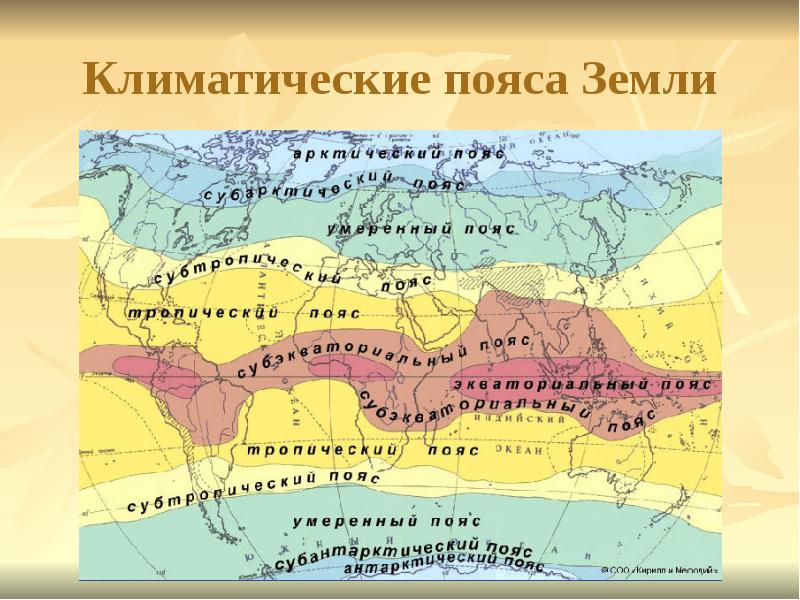
Equatorial Climate Belt
The territory located within this belt is characterized by
the predominance of equatorial air masses and low atmospheric pressure; high air temperatures and high rainfall throughout the year.
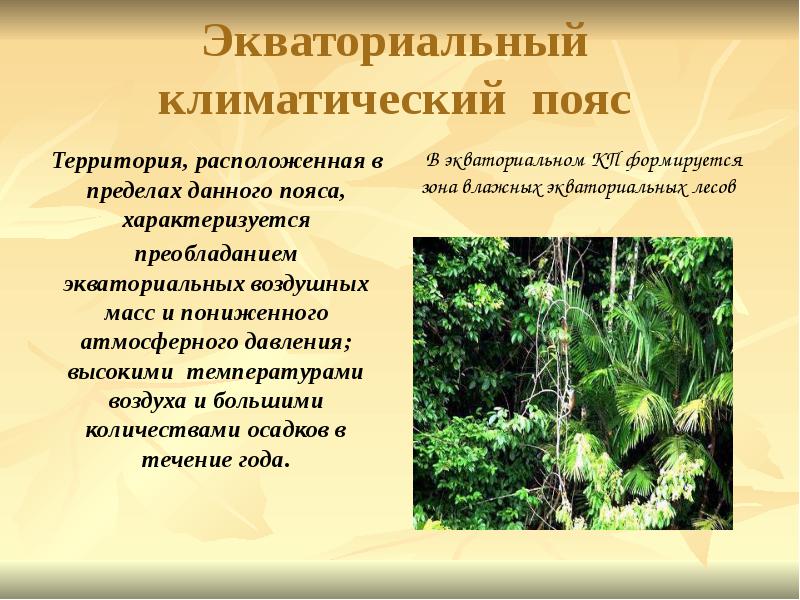
Types of housing in the equatorial belt
Stilt houses are common in the southeast. Asia, Oceania, in some areas of Africa and South America. Such buildings They are reliable flood protection. Light bamboo huts, covered with palm leaves, stand high above the ground, and residents are not afraid of either floods or predators.
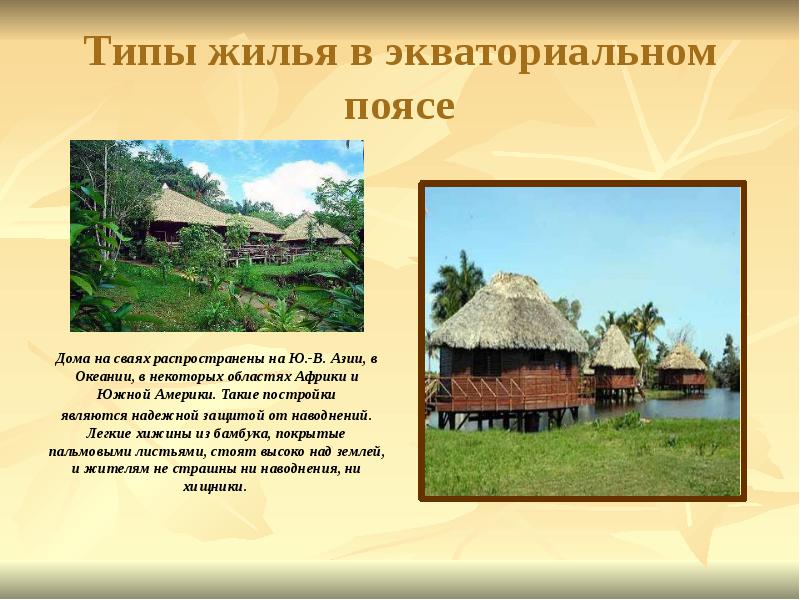
Inhabitants of equatorial forests
A humid and hot, stable climate, generously supplying a person with everything necessary, has led to the emergence of peoples not inclined to long hard work. Some tribes of rainforests do not know how to build dwellings, sculpt pots, cultivate the soil
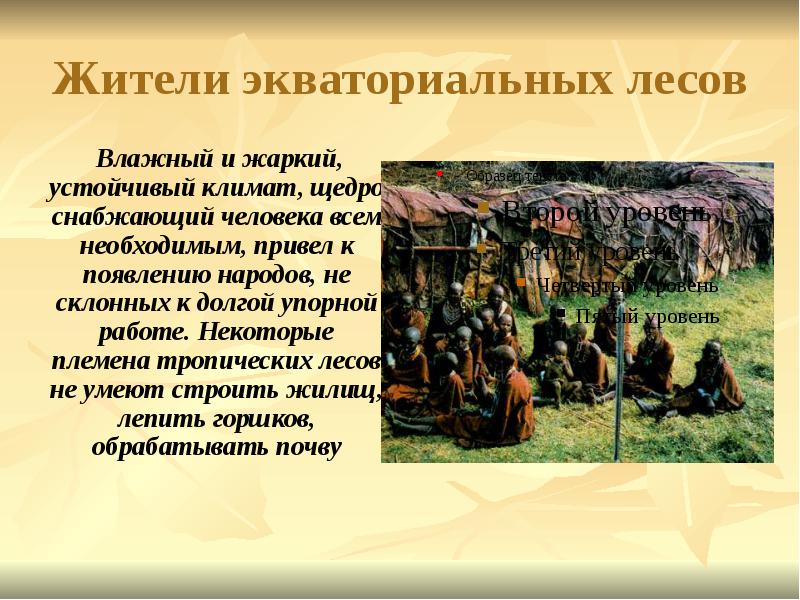
Subequatorial belt
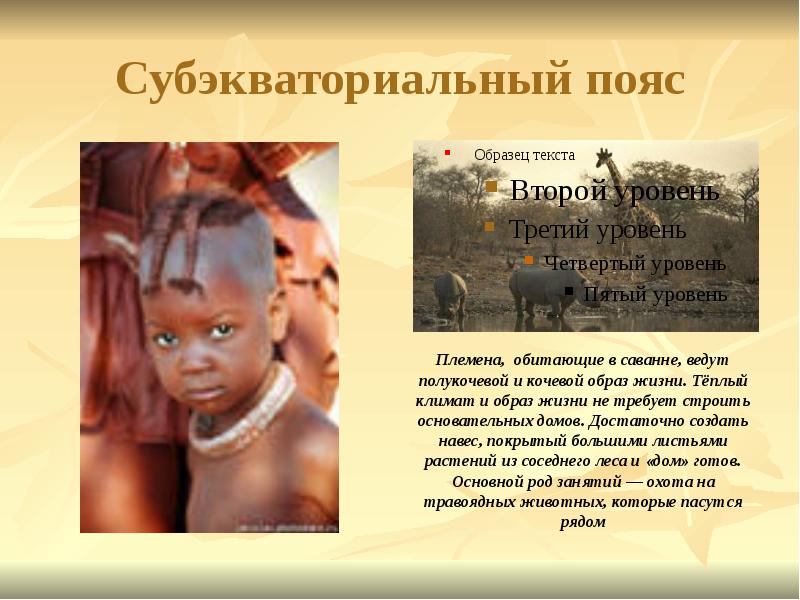
The inhabitants of the savannah and woodlands
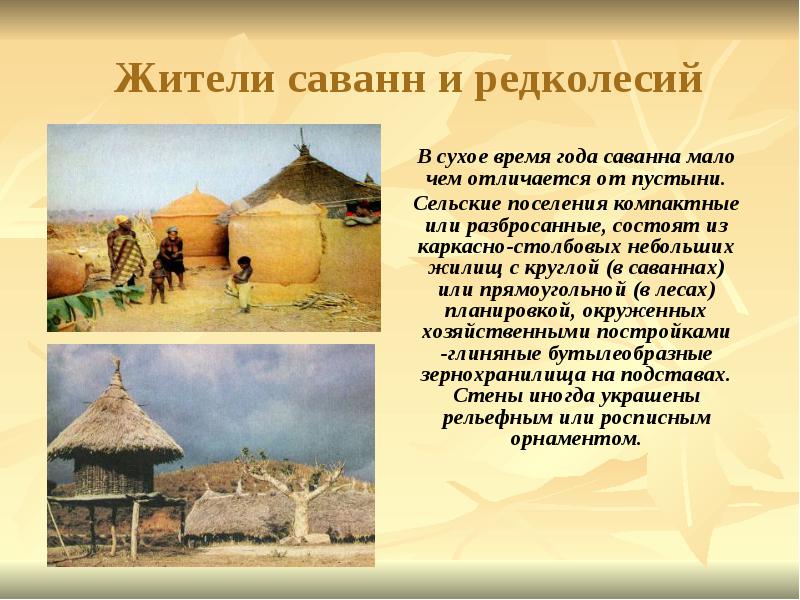
Tropical climate zone
The territory within the tropical zone is characterized by high atmospheric pressure and the dominance of tropical air masses; in summer high air temperature, in winter - cool. Rains are a rare occurrence.
The zone is poor in vegetation.
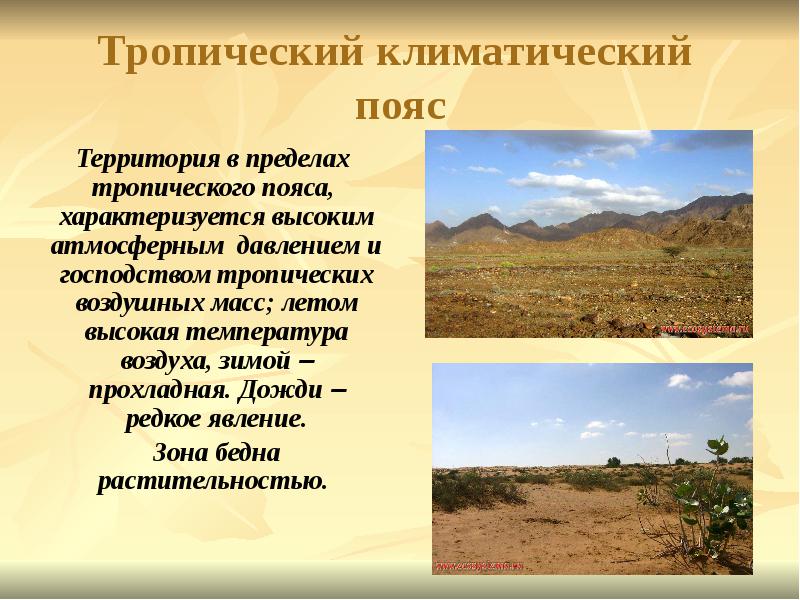
Typical Deserts in Asia
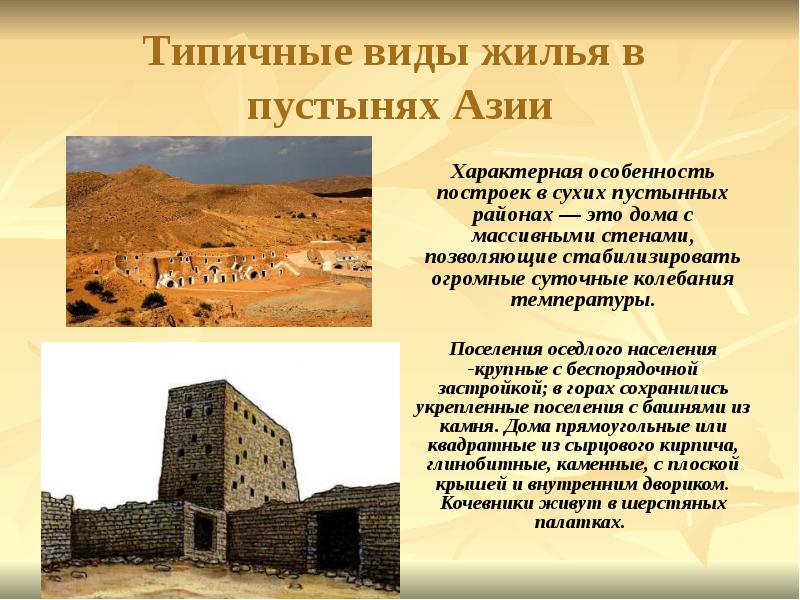
Pueblo

Inhabitants of equatorial forests
A humid and hot, stable climate, generously supplying a person with everything necessary, has led to the emergence of peoples not inclined to long hard work. Some tribes of rainforests do not know how to build dwellings, sculpt pots, cultivate the soil

Subequatorial belt

The inhabitants of the savannah and woodlands

Tropical climate zone
The territory within the tropical zone is characterized by high atmospheric pressure and the dominance of tropical air masses; in summer high air temperature, in winter - cool. Rains are a rare occurrence.
The zone is poor in vegetation.

Typical Deserts in Asia

Pueblo
The zone is poor in vegetation.

Typical Deserts in Asia

Pueblo
In dry, treeless, as well as in foothill and mountainous areas, starting from the Neolithic, stone, adobe, raw brick, adobe and combined dwellings of various types developed, which still exist today in Central, Central and Western Asia, the Caucasus, Y.-V. Europe, North Africa, South-West North America, Mexico, Yucatan, Andean Highlands.
Often such dwellings, closely interconnected and even piling one on top of the other, form multi-tier stone or adobe structures (for example, settlements of the type pueblo in the southwest North America).
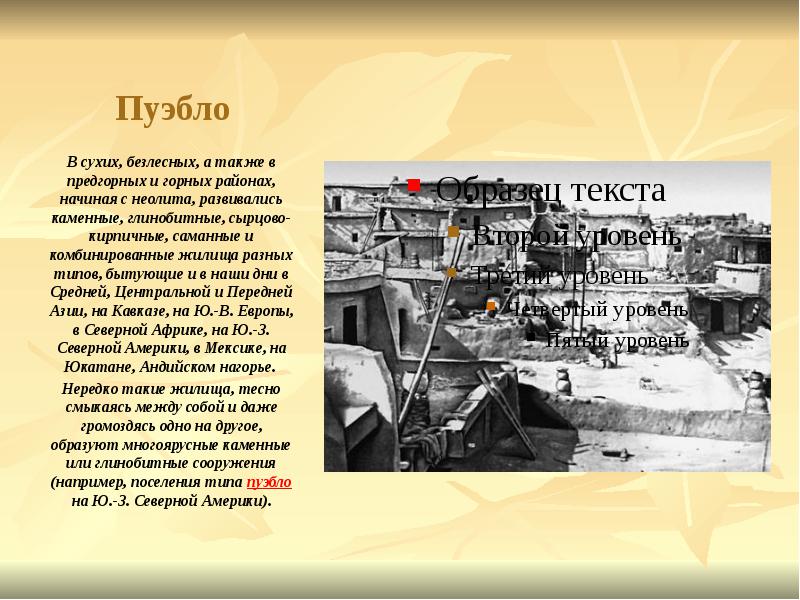
Desert Dwellings
Nomadic Bedouin Arabs in Saudi Arabia now contemptuously call sedentary Arabs clay people, and they proudly call themselves wool people - because they live in tents made of coarse fabric, which Bedouin women make from goat hair. This wool is good because the material from it hardly absorbs water, otherwise the tent after the rain would have been impossible to load on a camel - it is already quite heavy. In cold areas, tents usually have double walls, and the open side of the dwelling is hung with a special curtain.
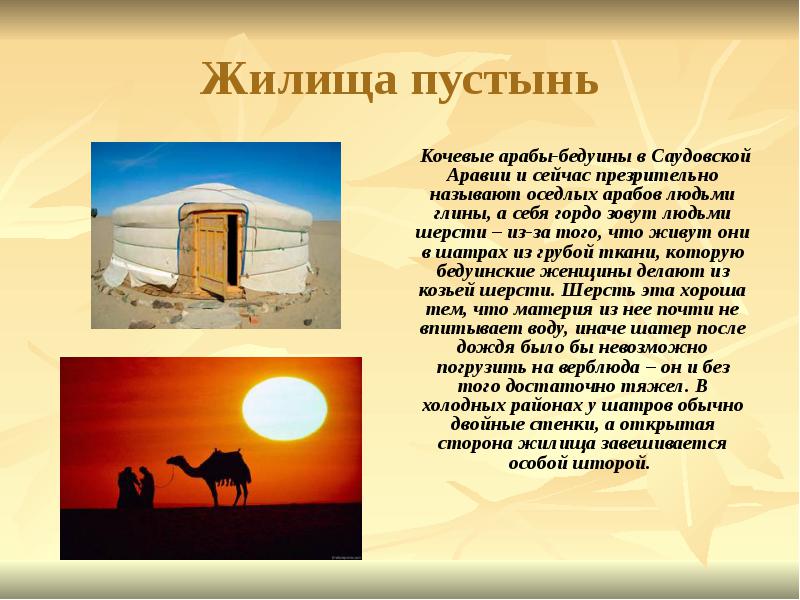
Wet tropics and subtropics
Unlike the dry tropics, they are rich in forests. In warm and humid zones - houses of the pavilion type, for the possibility of through ventilation. The traditional homes of Australian aborigines are wind screeners, awnings, huts. In Oceania - frame-pillar with a high gable roof of palm leaves.
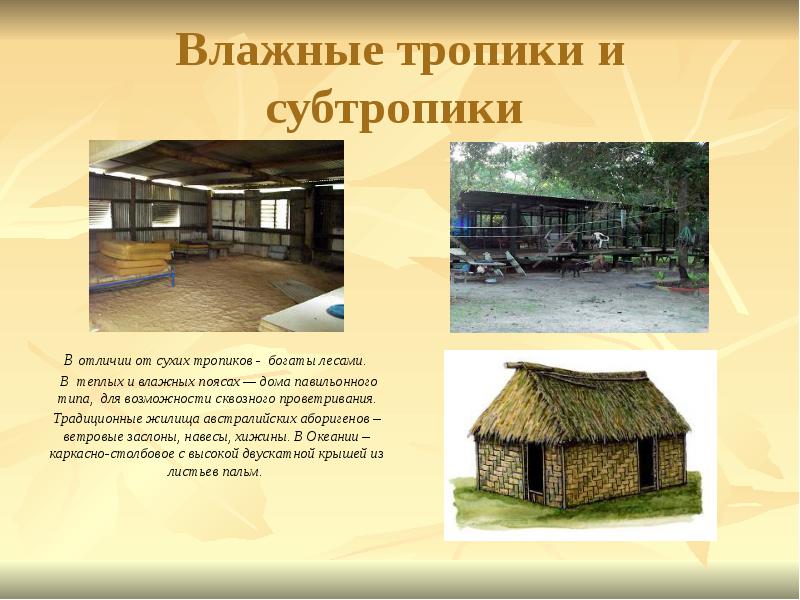
Temperate climate zone
The traditional homes of Australian aborigines are wind screeners, awnings, huts. In Oceania - frame-pillar with a high gable roof of palm leaves.

Temperate climate zone
This KP occupies vast areas of the Earth. Main features:
the prevalence of temperate air and westerly winds; distinctly expressed seasons. The growing continental climate from west to east, cold winters and hot summers. There are a lot of precipitation, but they are not evenly distributed..
The plant world is diverse, with a predominance of coniferous and deciduous forests.
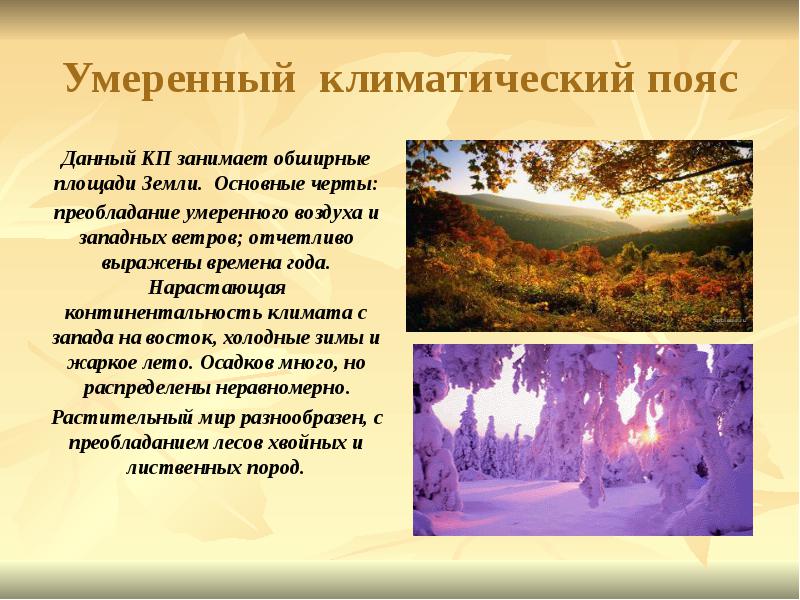
Typical Temperate Housing
In regions with cold winters, compact houses were built with thick heat-insulated walls and small windows. Representative countries are Canada, Russia, and Norway. Since these latitudes are rich in forests, the main building material is wood.
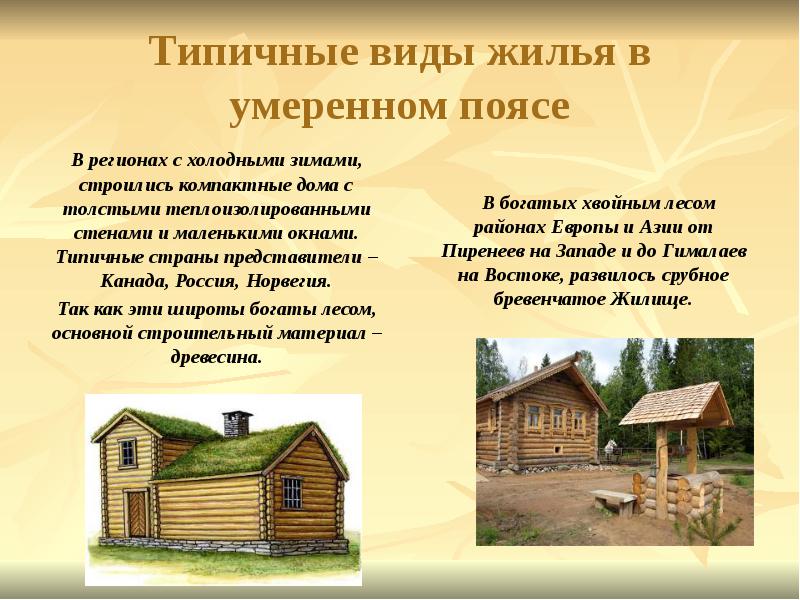

Steppes and semi-deserts of the temperate zone
The steppes and semi-deserts of the arid zone of the temperate zone of Central Asia are characterized by the economic and cultural type of semi-nomadic and semi-saddry cattle farmers with portable, collapsible dwellings in the form of yurts of various kinds.
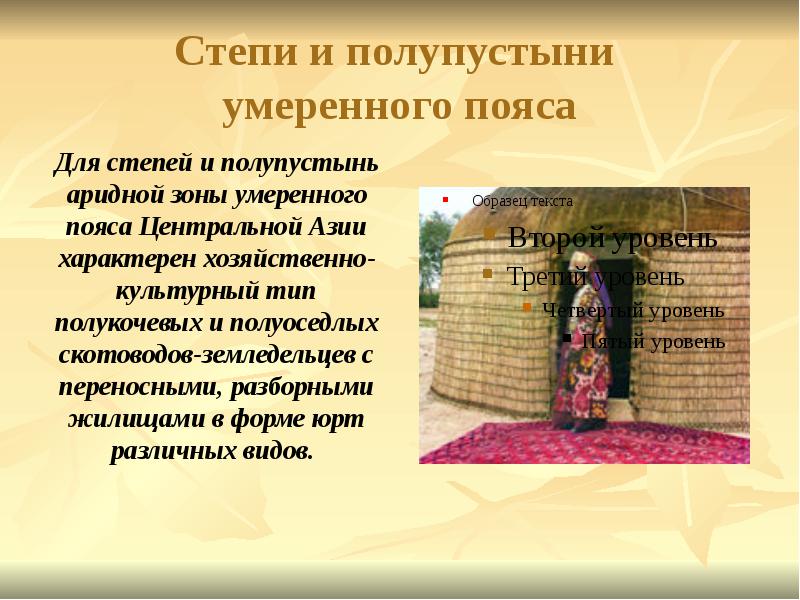
Arctic and Antarctic Belt
The prevalence of cold air masses, low air temperatures all year round, low rainfall. The absence of almost any vegetation, except for mosses and lichens.
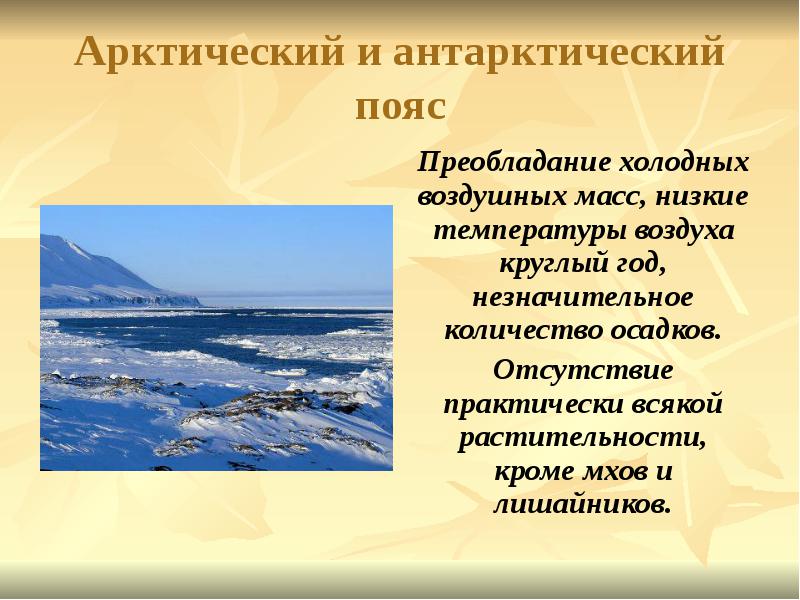
Arctic and Subarctic
Igloo is a house made of blocks of snow, usually domed, which is built by the Eskimos of Canada and Greenland in winter camps. Yarangi - the traditional home of the Eskimos, reindeer herderswhich was also built from improvised material. The walls of yarang were often lined with turf, made of stones or boards.
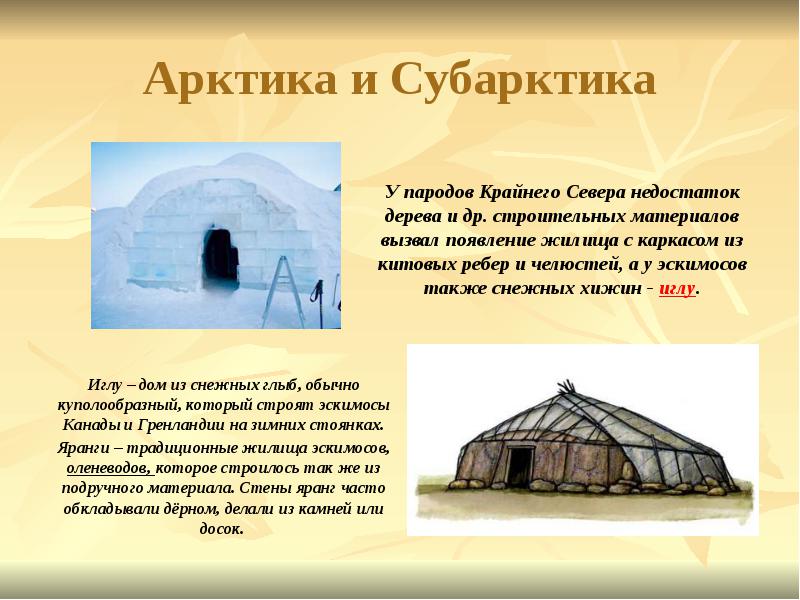
In conclusion:
The absence of almost any vegetation, except for mosses and lichens.

Arctic and Subarctic
Igloo is a house made of blocks of snow, usually domed, which is built by the Eskimos of Canada and Greenland in winter camps. Yarangi - the traditional home of the Eskimos, reindeer herderswhich was also built from improvised material. The walls of yarang were often lined with turf, made of stones or boards.

In conclusion:

Arctic and Subarctic
Igloo is a house made of blocks of snow, usually domed, which is built by the Eskimos of Canada and Greenland in winter camps. Yarangi - the traditional home of the Eskimos, reindeer herderswhich was also built from improvised material. The walls of yarang were often lined with turf, made of stones or boards.

In conclusion:

In conclusion:
The house is the beginning of the beginnings, in it we are born and go through our life path. Native home gives a feeling of comfort and warmth, protects from bad weather and troubles. It is through him that the character of the people, their culture, and the characteristics of everyday life are revealed to a large extent. The appearance of the dwelling, building materials and the method of construction depend on the environment, climatic conditions, customs, religion and the occupation of the people who create it. But no matter what housing is built and no matter how it looks, it is considered among all peoples the center around which the rest of the world is located.
Progress has stepped far forward, but many peoples continue to live and build traditional houses that are characteristic of their area.
Man has always called his house a fortress.

Conclusion:
1. Housing is one of the most important elements of the material culture of every nation.
2. The architecture of the peoples of the world always takes into account the climatic conditions and lifestyle of a person.
3. The home must meet all the necessary requirements to ensure a comfortable and safe stay. When building his house, a man strives to ensure that it is for him first of all:
- practical, opposed and protected him from all natural adversities;
- convenient for life to flow easily useful;
- and finally, beautiful, for the joy of the eyes of the owner and beauty on Earth.

Information sources:

Card index (senior group) on the topic: Educational games for children of the senior group of kindergarten
Wet tropics and subtropics
Consultation for educators "Educational activities in sensitive moments
Synonyms of English language explanation of differences in Russian
Room decoration in kindergarten: reception room, bedroom, locker room, music room